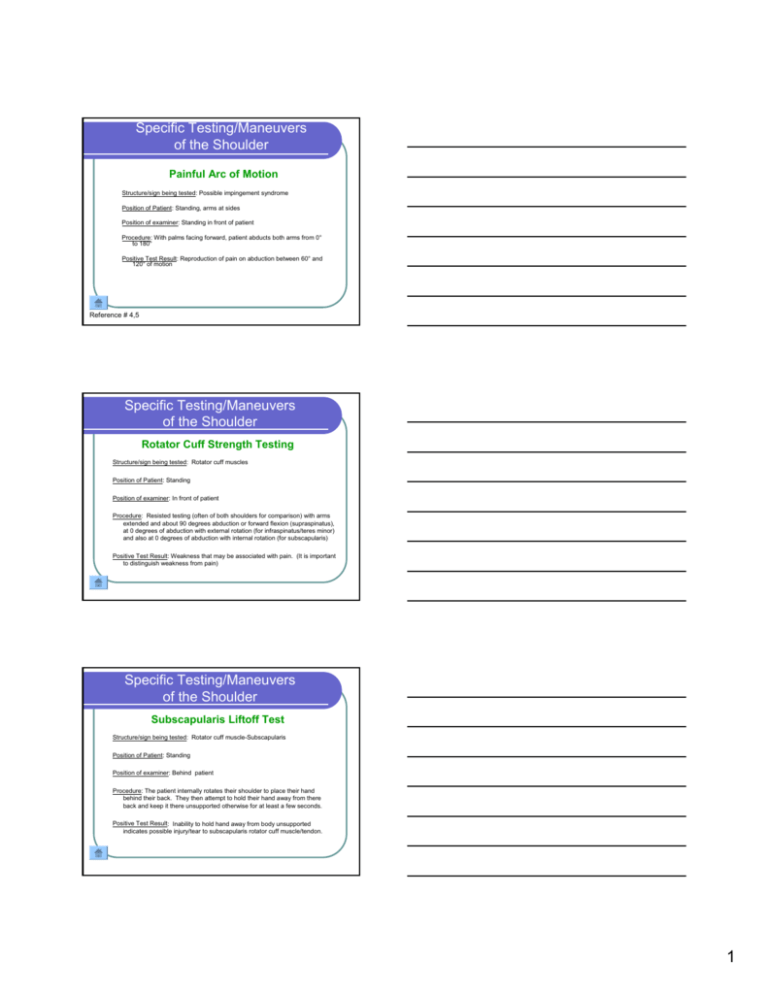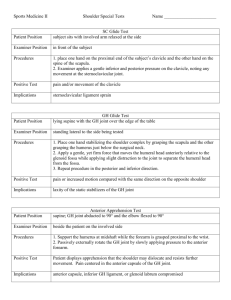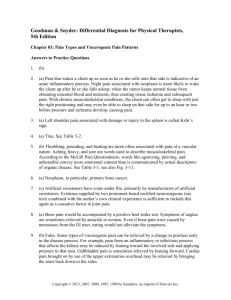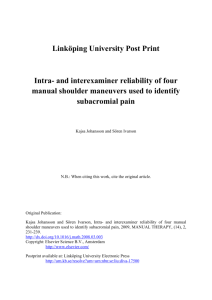Specific Testing/Maneuvers of the Shoulder Specific Testing
advertisement

Specific Testing/Maneuvers of the Shoulder Painful Arc of Motion Structure/sign being tested: Possible impingement syndrome Position of Patient: Standing, arms at sides Position of examiner: Standing in front of patient Procedure: With palms facing forward, patient abducts both arms from 0° to 180° Positive Test Result: Reproduction of pain on abduction between 60° and 120° of motion Reference # 4,5 Specific Testing/Maneuvers of the Shoulder Rotator Cuff Strength Testing Structure/sign being tested: Rotator cuff muscles Position of Patient: Standing Position of examiner: In front of patient Procedure: Resisted testing (often of both shoulders for comparison) with arms extended and about 90 degrees abduction or forward flexion (supraspinatus), at 0 degrees of abduction with external rotation (for infraspinatus/teres minor) and also at 0 degrees of abduction with internal rotation (for subscapularis) Positive Test Result: Weakness that may be associated with pain. (It is important to distinguish weakness from pain) Specific Testing/Maneuvers of the Shoulder Subscapularis Liftoff Test Structure/sign being tested: Rotator cuff muscle-Subscapularis Position of Patient: Standing Position of examiner: Behind patient Procedure: The patient internally rotates their shoulder to place their hand behind their back. They then attempt to hold their hand away from there back and keep it there unsupported otherwise for at least a few seconds. Positive Test Result: Inability to hold hand away from body unsupported indicates possible injury/tear to subscapularis rotator cuff muscle/tendon. 1 Specific Testing/ Maneuvers of the Shoulder Neers Impingement Test Structure/sign being tested: Impingement syndrome, compression of the greater tuberosity against the inferior acromion Position of Patient: Sitting or Standing Position of examiner: Standing lateral to involved limb. The patients shoulder is stabilized on the posterior aspect with one hand, the other hand grasps the patients arm at the elbow Procedure: With elbow extended, the shoulder is passively flexed to its end range Positive Test Result: Terminal forward flexion causing pain Reference # 4,5,13 Specific Testing/Maneuvers of the Shoulder Hawkins Impingement Test Structure/sign being tested: Impingement of the supraspinatus tendon under the coracoacromial arch Position of Patient: Sitting or standing Position of examiner: Standing lateral to involved limb, the patients shoulder is stabilized on the posterior aspect with one hand, the other hand grasps the patients arm at the elbow Procedure: The shoulder and elbow are first passively flexed to 90°, then the shoulder is passively internally rotated (with some force) Positive Test Result: Pain is a positive sign, especially near end range Reference # 4,5,8 Specific Testing/Maneuvers of the Shoulder Sulcus Sign Test Structure/sign being tested: Integrity of the inferior capsule of glenohumeral joint Position of Patient: Sitting with arms relaxed and hanging at their side Position of examiner: Standing behind or beside the patient. One hand palpates the shoulder by placing the thumb and fingers on the anterior and posterior aspects of the humeral head. The other hand grasps the arm just proximal to the elbow Procedure: While palpating and observing the humeral head, inferior traction is applied Positive Test Result: An observable and/or palpable space or sulcus between humeral head and acromion when compared bilaterally Reference # 4,11 2 Specific Testing/Maneuvers of the Shoulder Anterior Apprehension Test Structure/sign being tested: The anterior capsule of the glenohumeral joint Position of Patient: Lying supine, or sitting. Position of examiner: Standing behind or beside the patient. One hand is placed just distal to the shoulder, while the other hand supports the forearm proximal to the wrist Procedure: The shoulder is abducted to 90°, and the elbow is flexed to 90°. The examiner passively externally rotates as far as patient will allow Positive Test Result: Sensation of instability, not pain, reflected by facial or verbal visualization Reference # 4,9,11 Specific Testing/Maneuvers of the Shoulder Yergasons Test Structure/sign being tested: Checking for subluxation/pain of the long head of the biceps tendon in bicipital groove, indicating laxity of the transverse humeral ligament Position of Patient: Sitting with arm at 0° abduction, elbow flexed to 90°, and forearm pronated Position of examiner: One hand is used to stabilize the elbow against the body, the other hand is placed on the forearm proximal to the wrist Procedure: The examiner resists the patients attempt to supinate the forearm and externally rotate the shoulder Positive Test Result: Subluxation, snapping or popping in the bicipital groove Reference # 4,5,9,15 Specific Testing/Maneuvers of the Shoulder Speeds Test Structure/sign being tested: Biceps tendonitis, possibly ruptured biceps tendon Position of Patient: Sitting with elbow extended, and forearm supinated Position of examiner: The fingers of one hand are placed over the bicipital groove, the other hand is place on the forearm proximal to the wrist Procedure: The examiner resists forward flexion to 90° while palpating the bicipital groove Positive Test Result: Pain over bicipital groove Reference # 4,5 3






